Preview Iowa State's Smithsonian Folklife Festival exhibit June 12
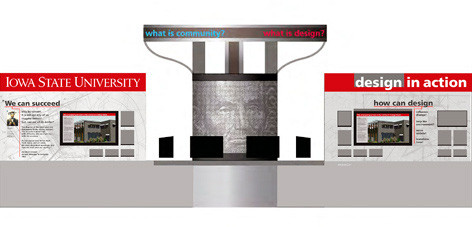
Iowa State's Smithsonian Folklife Festival exhibit features a center column of LED panels integrated with interactive touchscreen workstations. TV monitors on the side panels will show video of community projects and student designs. Interactive activities will happen on the other side. Photos by Bob Elbert.
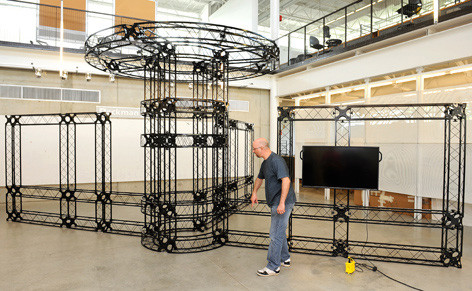
The T-shaped exhibit structure is a powder-coated, steel truss system that goes together in about an hour, says Anson Call, associate professor of art and design.
What weighs nearly a ton, gleams bright with 130 LED panels of images and ideas, plays games, tells stories, solves problems, interacts, interprets, and sometimes sounds very much like Simon Estes speaking Abraham Lincoln's words?
It's Iowa State's land-grant greatness on display. And before the university's exhibit "Transforming Communities: Design in Action" is packed up and shipped to the 2012 Smithsonian Folklife Festival in Washington, D.C. , the university community is invited to a sneak peek on June 12. The open house preview will be from 10:30 a.m. to noon, Tuesday, in the lower level of the King Pavilion, College of Design.
The product of months of creative collaboration by dozens of faculty, staff and students from the College of Design and ISU Extension and Outreach, the exhibit showcases the central role of design in the land-grant mission and extension's impact on communities. It mixes advanced, interactive technology with old-fashioned, personal conversation to communicate how faculty, students and Extension specialists use design thinking when working with communities to solve complex problems.
Iowa State was one of only 17 land-grant universities selected to exhibit in the festival's celebration of the 150th anniversary of the signing of the Morrill Act — which laid the foundation for land grants — and the creation of the U.S. Department of Agriculture. The Smithsonian Folklife Festival was inaugurated in 1967 and attracts more than 1 million visitors to the National Mall each year. This summer's festival will be June 27-July 1 and July 4-8.
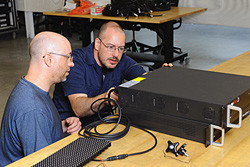
Anson Call (left) and David Ringholz, associate professor and director of industrial design, check a PDD controller that will drive 24 LED panels.
Iowa State's project is led by Chitra Rajan, associate vice president for research, Cathann Kress, vice president for extension and outreach, and Luis Rico-Gutierrez, dean of the College of Design. Sandra Norvell, Center for Excellence in the Arts and Humanities, coordinated the project development. The "Transforming Communities: Design in Action" exhibit also will be part of the university's exhibit in the Varied Industries Building at the Iowa State Fair, Aug. 9-19, and one of the Extension and Outreach exhibits at the Farm Progress Show, Aug. 28-30, in Boone.
Regents assign tuition set aside solution to a committee
The state Board of Regents wants to end its policy of setting aside tuition income for student financial aid. Meeting Wednesday in Iowa City, the board asked a committee of university, university foundation and board office staff to propose a five-year plan for eliminating the practice and to recommend alternative funding options, such as a state-funded grant program and larger foundation contributions to student financial aid. The board's focus is on funding need-based aid for undergraduate resident students.
The committee was asked to present a preliminary report at the board's September meeting and a final report at the October meeting.
Iowa State's committee members are student financial aid director Roberta Johnson, ISU Foundation vice president Larissa Holtmyer Jones and associate vice president for business and finance Pam Cain.
"We want to have a plan we can share with the governor and Legislature as we ask for their help," said regent Bruce Rastetter. He said he's also looking for strategies for working with the universities' foundations, particularly on merit-based scholarships that would help keep Iowa's brightest high school graduates in the state.
But he noted that a primary goal of any recommendation must be maintaining access to a college education for Iowa students in need.
According to board data, the ISU Foundation contributes about $15 million annually to undergraduate student financial aid at Iowa State. Tuition set aside at Iowa State contributes in excess of $50 million to the financial aid central fund.
Board president Craig Lang said he has received many emails from parents asking for immediate elimination of tuition set aside at Iowa's public universities.
Regent David Miles said that the current set-aside program "accomplishes many good things" and asked that any changes to it "not take any steps backward, especially regarding access to education for the neediest students in our state."
The decades-old practice drew criticism from legislators this spring, prompting the board to agree to study it.
In Iowa, the practice of using a portion of tuition revenues for student financial aid goes back to the 1960s. Since FY03, board policy has required the three regents universities to set aside a minimum of 15 percent of tuition revenue for financial aid. In the face of state funding cuts and the resulting tuition increases, the actual practice typically has been more generous than that. In recent years, Iowa State has set aside 22 to 23 percent of tuition revenue for aid.
Accountability for financial resources
The board approved an additional annual reporting requirement for the three universities intended to "increase the clarity and accountability of how Iowa's public universities spend their resources." The report will be due each fall and include four components, for which templates are provided. They are:
- Summary of state operating appropriations and tuition expenditures by these functions: instruction, public service, research, student services, academic support, institutional support, scholarships and fellowships, and operations/maintenance
- Comparison of the university's functional spending (above) with its peer schools
- Break out of "instruction" function dollars by these divisions: lower division and upper division undergraduates, master's, advanced graduate and professional
- Summary of how incremental increases and reallocations were spent and how they support the university's core mission
Rastetter said the information would be useful to the governor, legislators and other stakeholders in the state.
In other business, the board approved nominating Richard Jacobsen of Des Moines for the Iowa Award, the state's highest citizen award for public service, in recognition of his numerous and generous gifts to the three regent universities.
Other Iowa State requests that the board approved are:
- Add $1.2 million to the budget of the Curtiss Hall renovation project. The increase reflects the need to add central air conditioning to rooms with window units (required by window replacement) and difficulties encountered in modernizing a 104-year-old building while it remains occupied. The revised budget is $14.3 million; the increase will be covered by university funds.
- Revisions to proposed changes to the elevated walkways at the Iowa State Center that add landscaping, parking and roadway improvements, and development of a master plan for the center complex. The project budget went from $1 million to $2.5 million and still will be covered with facilities use funds.
- Name the department of biochemistry, biophysics and molecular biology for the Roy J. Carver Charitable Trust, in recognition of the trust's latest gift to the department -- $7.5 million to support new initiatives in the area of biomolecular structure. The name change is effective immediately.
- An initial 10-year lease between Ames area developer Dickson Jensen and the athletics department on a yet-to-be-constructed indoor golf practice facility on South Duff Avenue. Jensen will pay to build the facility; the department will pay about $235,000 a year to lease it for the men's and women's golf teams. The source of the funds is athletics operating revenues and private gifts.
- A 50-year lease with the city of Ames for a small parcel of land in the southwest corner of the city's Moore Memorial Park, north of Veenker golf course. Iowa State will reconstruct a golf maintenance building there, out of the Squaw Creek flood plain. The existing building has sustained flood damage numerous times in the last 30 years. Flood insurance reimbursements and FEMA funds will pay for the relocation. In lieu of lease payments, the city would be allowed to store maintenance equipment in the building and, if it has a basement, have a public access storm shelter included in the lower level.
- The appointment of Jonathan Wickert as senior vice president and provost, effective July 30, and a salary of $350,000.
Leath shares preliminary budget information
A 3 percent increase ($5.2 million) in the operations appropriation from the state and additional tuition revenue (estimated $33.4 million) spurred by a fall enrollment projected to exceed 31,000 students highlight a preliminary budget for the fiscal year that begins July 1. President Steven Leath shared revenue and cost increases, university priorities and FY13 salary increase parameters with Iowa State leaders in a second budget memo last week. His authorship reflects the transfer of overall budget and planning coordination back to the president's office from the provost office, where it had resided since 2006.
As directed in the budget memo, Iowa State units will finalize their budgets by June 22. A final FY13 budget will be submitted to the state Board of Regents office in early July, with approval anticipated at the board's Aug. 3 meeting.
With slight increases anticipated in other revenue streams, Iowa State will have nearly $39.7 million in new operating revenues to work with in FY13.
What will it fund?
An estimated $6.8 million (20 percent) of the new tuition revenue will be set aside in a central fund for student financial aid.
Leath approved $10.2 million in funding for institutional priorities and for compensation increases in units that don't receive tuition or fee-for-service income in the budget model. New funds will complete and make permanent an annual $2.5 million commitment to university marketing campaigns and $2 million to the development of university-wide administrative software systems. It will add funds, $1 million and $2.5 million, respectively, to rebuild the deferred maintenance and Institutional Excellence funds.
It will provide permanent funding to institutional programs such as the ombuds and sustainability offices, university lectures program and Reiman Gardens, and provide additional funding to equal opportunity and compliance, and University Museums. It also will provide funds for compensation increases in central research and economic development offices and centers, and in ISU Extension and Outreach. It provides funds to operate Troxel Hall when it is completed next spring.
The budget model's six central service centers (library, student services, facilities services, IT services, business services and academic support programs) will share nearly $7.1 million. This essentially is an increase in their spending authority for services provided to campus clients. In most cases, the funds will cover both additional services and compensation increases for the employees in the service units. In his memo, Leath noted that three years of state funding cuts and growing undergraduate enrollments have strained their ability to serve students and university employees well.
The remaining new dollars – about $15.6 million – will be distributed among the colleges according to enrollment and student credit hours offered. There, they'll cover compensation increases and other priorities identified by college leaders.
FY13 operating budget: Proposed distribution of new funds
| Colleges | $15.56 million |
| Administrative Service Centers (6) | $7.09 million |
| Student financial aid | $6.81 million |
| Institutional Excellence Fund | $2.50 million |
| Research, Extension units | $1.66 million |
| Institutional programs | $1.40 million |
| University marketing campaign | $1.37 million |
| Administrative software systems | $1.37 million |
| Deferred maintenance fund | $1.0 million |
| President, provost units | $0.73 million |
| Troxel opening, other | $0.19 million |
| Total | $39.68 million |
Salary increases
Two documents, the university's year-old salary policy and the AFSCME contract, will shape how much of the additional revenues actually are used for salary increases. (Medical and dental benefits costs will go up 5 percent for all employee groups.) The salary policy, which covers faculty, professional and scientific staff, and post docs, requires university leaders each year to set minimum and maximum increases for employees receiving a satisfactory – or better – performance evaluation. For FY13, those parameters are:
- 1.0 percent minimum increase for those with salaries above $60,000
- 1.5 percent minimum increase for those with salaries at or below $60,000
- 4.0 percent maximum increase threshold
Proposed increases above 4 percent will require units to receive approval at the vice presidential level, final approval from the office of the president and, this year, also from Board of Regents executive director Robert Donley.
During a campus forum last week, associate vice president for budget and planning Ellen Rasmussen explained that the differentiated minimum, suggested by Leath, recognizes that the economic downturn has a greater impact on households with smaller incomes.
The board of regents asked the three regent universities to hold their university-wide salary increase average at 2.5 percent or lower. It's possible that some units within the university could finish with higher averages than that. Setting an average increase target is not a green light for units to award across-the-board 2.5 percent increases, Rasmussen noted. Individual increases should reflect performance evaluations, market or equity issues and any special retention needs. Requests for salary increases above 4 percent are due to the respective vice presidential office by June 8.
Salary increases for the FY13 faculty promotions ($6,500 for Distinguished Professors, $6,000 for University Professors, $5,500 for full professors and $4,600 for associate professors) and increases due to P&S reclassifications don't replace or eliminate performance-based increases. Neither will they figure into the unit or university averages, Rasmussen said.
The state's contract with AFSCME (American Federation of State, County and Municipal Employees) that covers merit employees calls for a 2 percent increase on July 1 and a 1 percent increase on Jan. 1, 2013. Those merit employees not at the maximum of their pay scales will receive up to a 4.5 percent step increase on the anniversary of their hire dates. The estimated average increase among ISU's merit employees next year is 4.34 percent.
Non-operating funds
If Gov. Terry Branstad approves the FY13 state budget, Iowa State will receive $221,858,141 in state support for its operating budget. It also will receive $19 million in the second of a four-year state commitment to construct Phase 2 of the Biorenewables Complex, $1 million to the ISU Research Park for facility improvements to accommodate pancreatic cancer research at NewLink Genetics Corp., and just over $1 million to support research initiatives that will advance state economic development.
Osborn Drive entrance to close June 11
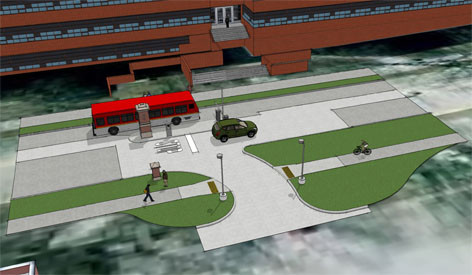
The east control gate on Osborn Drive is getting a facelift, which will close the campus entry point beginning June 11. The renovation work will eliminate the double-island entrance and create a single gated stop.
Barring delays, construction should be complete by the end of July. Stange Road provides vehicles an alternate entrance route during the project, and the west Osborn Drive entrance remains open.
Traffic flow
Currently, the east entrance has an initial voice box stop for visitors, and a second stop for passcard holders. Visitors unfamiliar with campus frequently miss the voice box and get trapped at the lowered gate without an option to turn around.
The new design (see illustration) moves the new single entrance east, giving drivers an option to avoid the gate with a direct turnoff into parking lot 40 (between the Seed Science Building and Kildee Hall's Iowa Farm Bureau Pavilion) and return to Wallace Road.
"The turnoff into lot 40 gives us the opportunity to direct more cars away from the campus core and make it safer for pedestrians," said ISU parking division manager Mark Miller.
Consistent look
The design will incorporate a look similar to the university's entrance on University Boulevard. Three red brick columns, landscaping and sidewalk improvements are part of the plan.
"This is part of an effort to identify and sign the university's major entries," said facilities planning and management landscape architect Rhonda Martin.
Doering named university registrar
Laura Doering, a longtime staff member in the registrar and admissions offices, will become Iowa State's next registrar July 1.

Laura Doering
Doering, currently senior associate registrar and director of transfer relations, was selected following a nationwide search. She has worked at Iowa State since 1996.
Previously, Doering was director of student activities and later, assistant registrar at Des Moines Area Community College, Ankeny. She holds a master's degree in education from Iowa State and a bachelor's degree in communication from Western Michigan University, Kalamazoo.
Doering serves on many university and statewide committees and has been president of the Upper Midwest Association of Collegiate Registrars and Admissions Officers. She also has received that association's Exemplary Service Award and is a frequent presenter at regional and national conferences.
Doering succeeds associate vice president for student affairs and university registrar Kathy Jones, who will retire at the end of 2012. Jones will continue in her role as associate vice president until that time.
New plantings replace ash trees
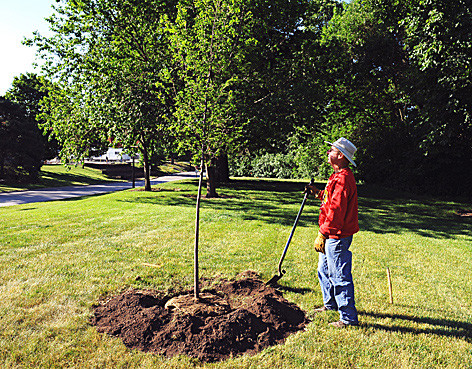
Groundskeeper Tim Wirth checks a young American Elm tree for straightness before backfilling dirt around it on a site west of the College of Design. Campus services crews are planting about 110 trees – nearly a dozen different species -- this summer to replace about 60 ash trees removed last fall and winter in preparation for the arrival of the emerald ash borer, dubbed "the green menace." This week, a dozen more ash trees in this same vicinity will be removed as part of the 10-year project. Wet slopes during the mild winter prevented crews from removing them as planned. Photo by Bob Elbert.
Input sought on future of Iowa State Center courtyard area
Public input on the future of the Iowa State Center courtyard area will be essential in the development of a site master plan. Facilities planning and management will hold its first open meeting June 18 (4:30 p.m., 004 Scheman Building) to give key stakeholders and the public an opportunity to share their visions for the space.
A $2.55 million project budget was approved by the Iowa Board of Regents at its June 6 meeting. The project will address the Iowa State Center's deteriorating elevated walkways, enhance the courtyard and green space areas, and improve accessible parking on the west side as part of a long-term master plan.
"This is an opportunity to enhance the outdoor courtyard spaces and accommodate future guest services and activities at the center," said Cathy Brown, FPM assistant director for campus physical planning. "We're really excited to create a vision for a wonderful space."
Walkways
Options for the elevated walkways include partial demolition and repairs and handrail replacements that comply with current safety codes. Updated -- and more efficient -- walkway lighting also will be included.
Master plan
FPM will hire a professional firm to lead the development of a site master plan. Public input will be encouraged throughout the process, including help in identifying ideas and options for future events and activities in the space. Landscaping, pedestrian and vehicular access, and special elements (such as artwork) will be part of the plan.
Funding
The project will be funded by facilities building use charge reserves.
Reception for Elizabeth Hoffman is June 21
The university community is invited to join president Steven Leath and senior vice presidents Warren Madden and Tom Hill at a reception to thank Elizabeth Hoffman for her outstanding contributions to Iowa State as executive vice president and provost. It will be held Thursday, June 21 (3:30-5 p.m., first floor atrium, Beardshear Hall). A program will begin at 4 p.m.
Hoffman announced her plans in February to step down from the provost post by the end of the calendar year, and a national search to find her successor began later that month. College of Engineering dean Jonathan Wickert will become senior vice president and provost on July 30.
Hoffman has served as provost since January 2007. Previously, she served Iowa State as dean of the College of Liberal Arts and Sciences from 1993 to 1997.
